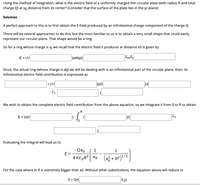Question
If possible please box each corresponding answer. Thanks.

Transcribed Image Text:Using the method of integration, what is the electric field of a uniformly charged thin circular plate (with radius Rand total
charge Q) at xo distance from its center? (Consider that the surface of the plate lies in the yz plane)
Solution
A perfect approach to this is to first obtain the E-field produced by an infinitesimal charge component of the charge Q.
There will be several approaches to do this, but the most familiar to us is to obtain a very small shape that could easily
represent our circular plane. That shape would be a ring.
So for a ring whose charge is q, we recall that the electric field it produces at distance x0 is given by
E = (1
Since, the actual ring (whose charge is dq) we will be dealing with is an infinitesimal part of the circular plane, then, its
infinitesimal electric field contribution is expressed as
= (1/
D(x0
24
We wish to obtain the complete electric field contribution from the above equation, so we integrate it from 0 to R to obtain
.R
E = (x0/
24
Evaluating the integral will lead us to
QXo
1
1
E=
4 TE,R? Xo (x3 + R²)?/2
For the case where in Ris extremely bigger than x0. Without other substitutions, the equation above will reduce to
E = Q/
Eo)
Expert Solution
This question has been solved!
Explore an expertly crafted, step-by-step solution for a thorough understanding of key concepts.
Step by stepSolved in 2 steps with 1 images

Knowledge Booster
Similar questions
arrow_back_ios
arrow_forward_ios